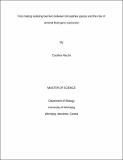| dc.description.abstract | Reproductive genes are known to be among the fastest evolving category of genes within the genome, and males’ reproductive genes show a high divergence between species. A class of genes expressed in the male’s reproductive tract, the Seminal Fluid Protein genes (SFPs), have been shown to be the most rapidly evolving male genes. The fast evolution and divergence of these genes were first attributed to forms of postcopulatory sexual selection and sexual conflict. However, a recent study that analyzed the molecular evolution of SFPs among different species of Drosophila at the coding sequence level found that the responsible force driving the rapid evolution of SFPs was relaxed selection, with only a small proportion evolving by positive selection. In this thesis, I focus on analyzing the molecular evolution of SFP genes at the gene expression level, rather than at the coding sequence level, and on understanding whether changes at the gene expression level can trigger the evolution of reproductive barriers. From my analysis, it emerged that SFP genes show a higher divergence in expression compared to the average accessory gland gene, but do not show a higher polymorphism. Moreover, after knocking down four genes under positive selection, that have been previously shown to affect intraspecific sperm competition, and after performing mating experiments both at the intra and interspecific level between D. melanogaster and D. simulans, we find no difference in the ability of the D. melanogaster knockdowns to outcompete heterospecific D. simulans males. These results suggest that genes influencing forms of postcopulatory sexual selection (i.e., sperm competition) and those influencing reproductive barriers (i.e., conspecific sperm precedence) do not share a common genetic basis. This hints to the possibility that, while intraspecific sperm competition can be affected by the perturbation of a single gene, the perturbation of more than one gene at the same time might be needed to affect conspecific sperm precedence. | en_US |

